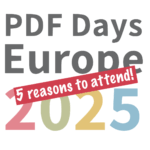PDF/X: The key facts

Dietrich von Seggern received his degree as a printing engineer, and in 1991 started his professional career as head of desktop prepress production in a reproduction house. He became involved in research projects for digital transmission of print files, and moved to the German Newspaper Marketing Organisation (ZMG). There Dietrich was … Read more


PDF/X is a subset of PDF – see “Technical side and requirements of PDF/X” for an overview. As such, conforming with PDF/X means accepting specific requirements and restrictions to the use of the PDF format.
One principle of PDF/X is that conforming files must be complete, i.e. fully self-contained. In addition, nothing may appear on a PDF/X page that is either not printable at all (such as video or 3D) or where print output is not fully defined (for example, if a font is not embedded). While the first rule is rather easy to implement, the latter is more difficult. PDF allows for many complex situations, for example, colors in semi-transparent overlapping objects. In other cases, it may not be clear whether objects on a layer are to be printed. There are many other cases of interdependencies in which it is difficult to determine whether the print result is unambiguously defined, or not.
Certain features needed only for some print applications (e.g., a bleed zone) are not required in PDF/X as they are not required in all print products. Wherever it makes sense in such cases, however, PDF/X requires that if such information is present, it must be accurate. PDF/X requires, for example, that if a bleed zone is defined then that zone must not be enclosed by the trimmed print product.
Core principles of PDF/X
These requirements apply in all parts and conformance levels of PDF/X.
- An Output Intent must be present that uses an ICC profile to specify the intended printing conditions (print device type, paper type) when colors (or shades of gray) are defined.
- Spot colors may only be used if they have an alternate color, and this alternate color must be the same for all occurrences of the respective spot color.
- Fonts must be embedded (either fully embedded, or as an embedded subset in which all characters used in the text are present).
- Images must be present in the PDF (no external graphical content is allowed).
- No password protection of any type.
- No transfer curves (since they modify appearance of colors).
- No alternate images (e.g. no low-resolution alternates).
- If the bleed zone is defined, the BleedBox must be outside the printable area (the TrimBox).
- No use of LZW compression.
- No annotations in the print area.
- No audio, video or 3D annotations.
- No form fields or JavaScript.
- No embedded files.
- PDF metadata must indicate whether the PDF has been trapped, or not.
- PDF metadata must claim conformance to PDF/X and to which part and conformance level of the PDF/X standard.
What’s not in PDF/X
PDF/X does not include provisions that although important, may vary depending on the printing conditions, e.g. the minimum image resolution or the bleed zone.
Other non-ISO standards have been developed based on PDF/X that cover such production specific requirements (see “Further quality requirements: PDF/X-Plus” for further information).




